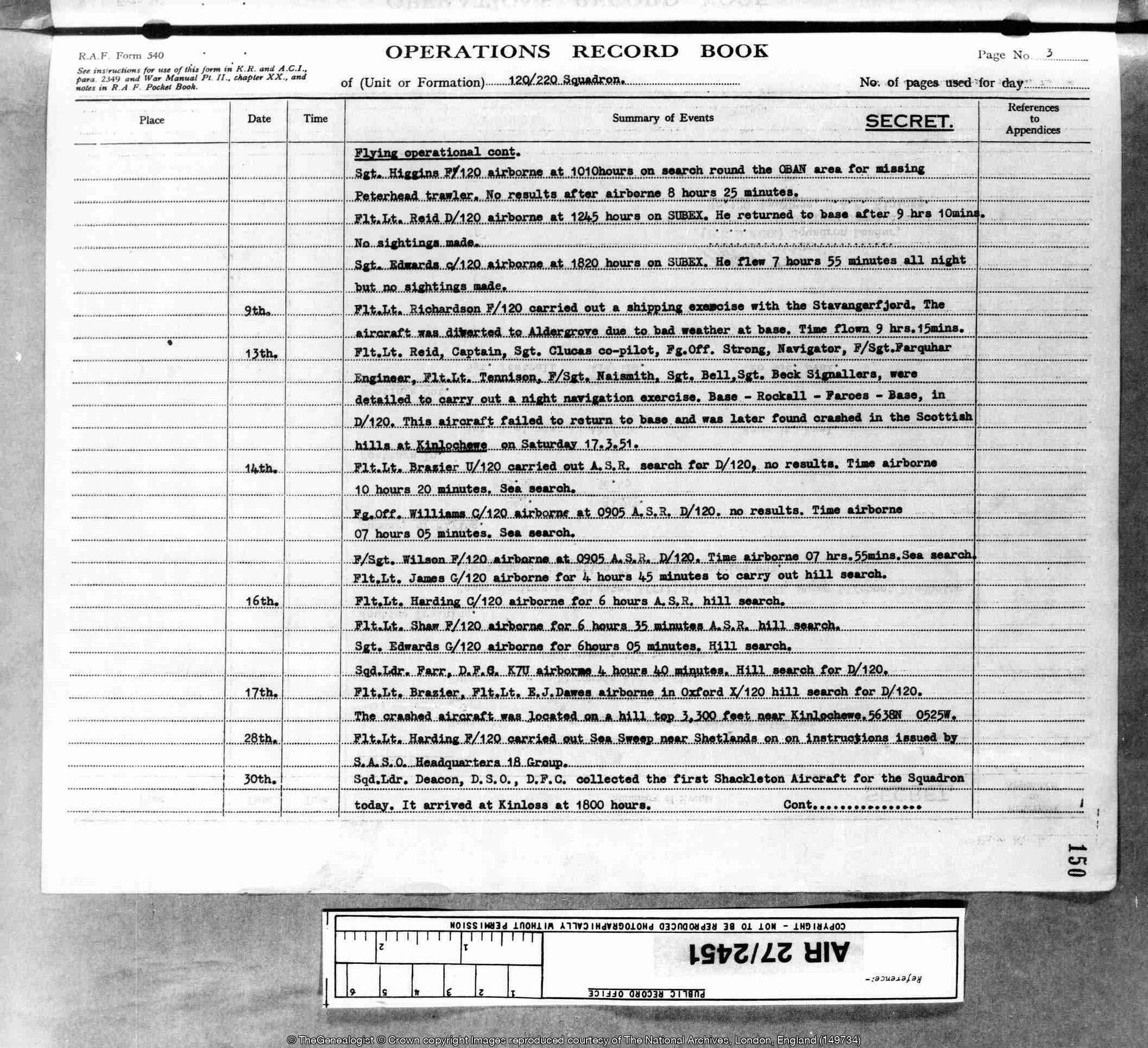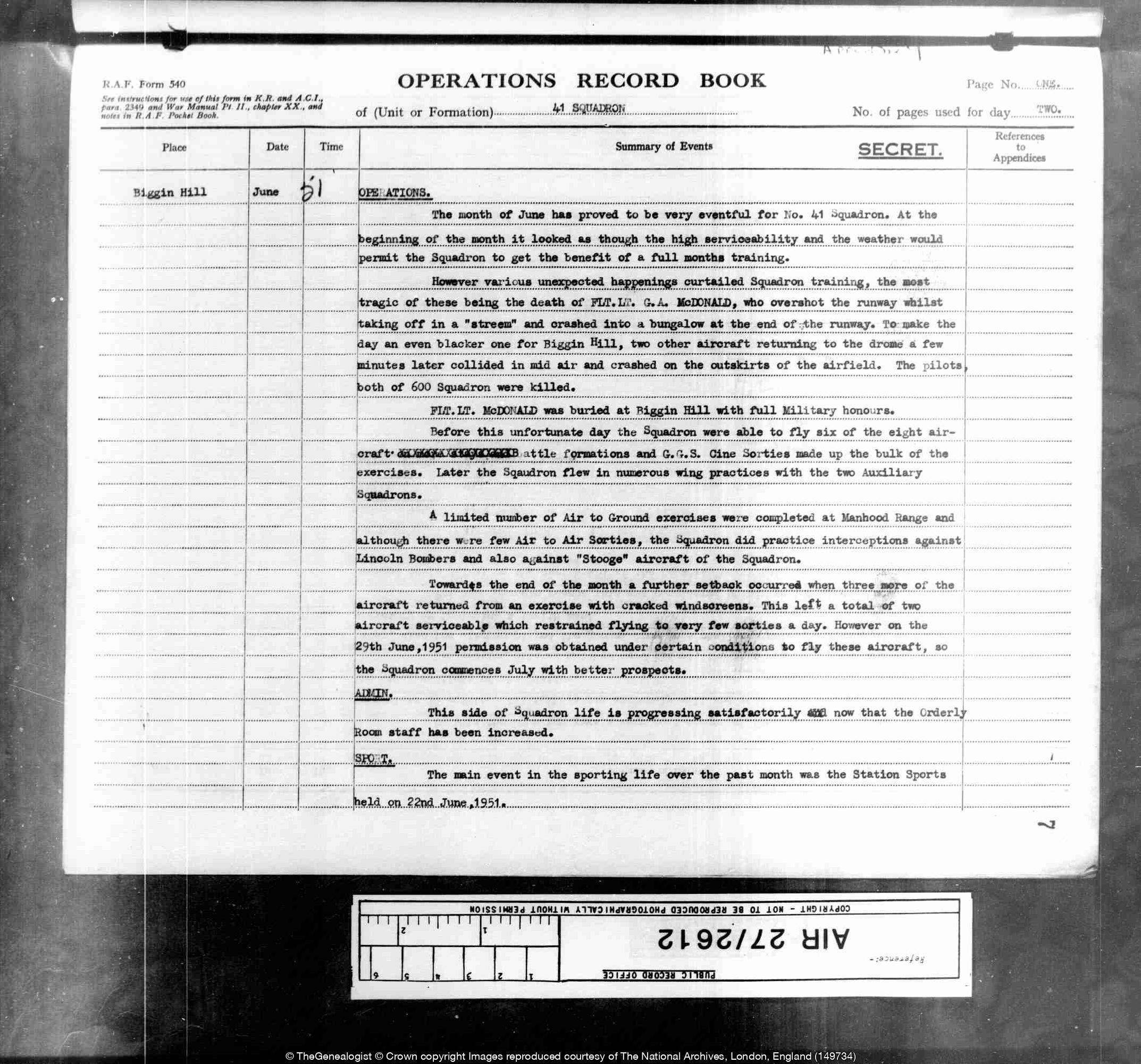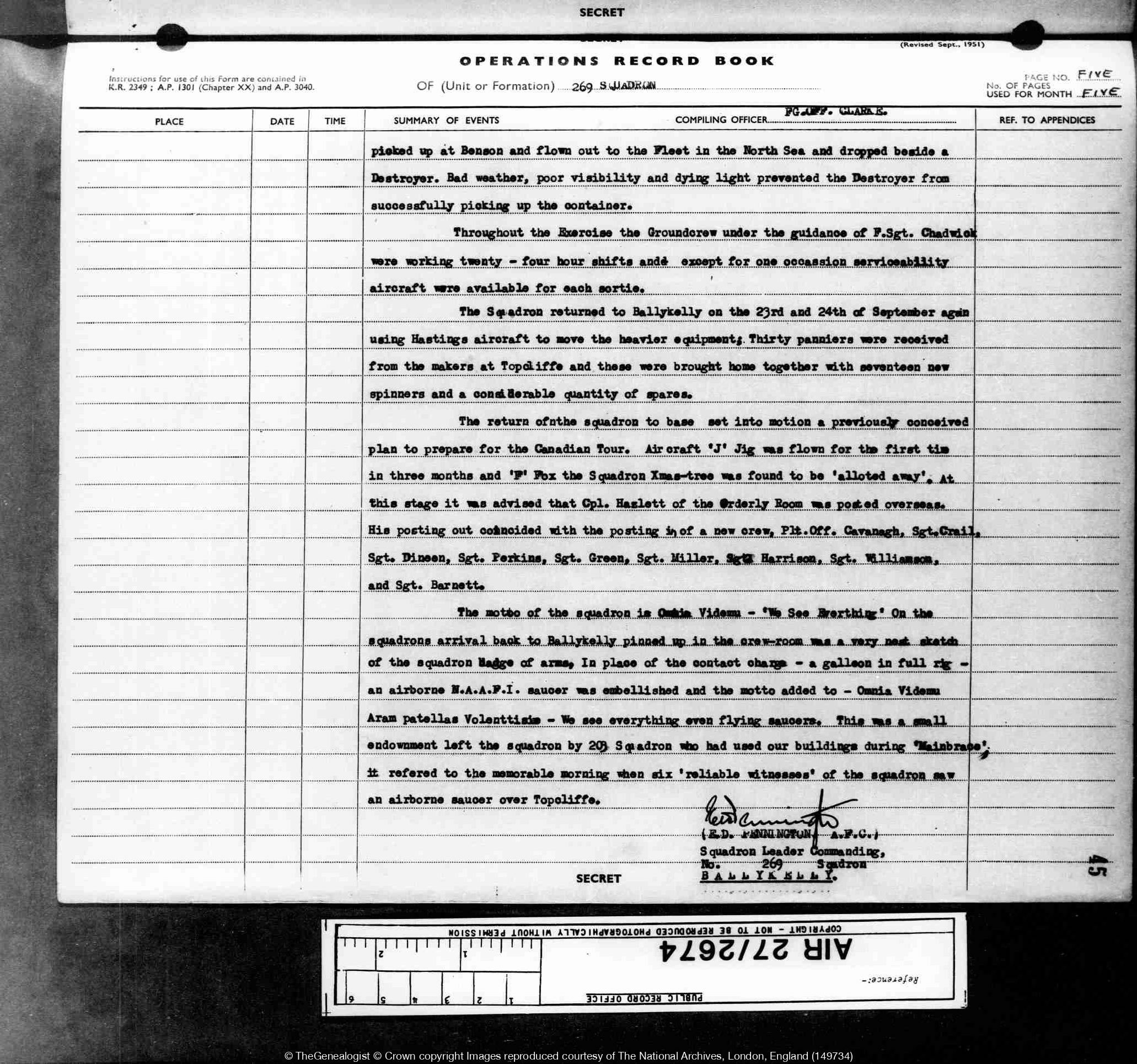It is fascinating what can be found in the records known as RAF Operations Record Books (ORBs) and released online by TheGenealogist. They not only deal with the wartime functions of air force squadrons, but they also extend into the 1950s and 60s. Thus, for those of us with relatives who had served after the war, we can make use of the entries in these official daily journals to discover about our RAF ancestors and what happened on a daily basis in their unit or squadron. Using record series AIR 27 from The National Archives these ORB records have been transcribed to make them fully searchable by TheGenealogist and linked to high quality images of the document pages. This makes these records an important and accessible resource for the family or aviation historian to easily use.

As this period was one of relative peace, notwithstanding the cold war and some minor conflicts, many of the ORBs record routine happenings on the bases from this period. However, there are some more unusual events to discover within their pages. There is, for example, the tragic loss of life as well as an aircraft when a Lancaster bomber came down at Kinlochewe in the Scottish Hills in March 1951. The Avro Lancaster B. Mk. III (D/120) had belonged to No 120 Squadron, RAF and had taken off from RAF Kinloss on the 13th March 1951 conducting a night navigation training exercise. After about six and a half hours in the air the crew had reported that they were approximately sixty miles to the North of Cape Wrath and then nothing. This was to be the last radio contact that anyone had with the aircraft and so by the following morning, as the aircraft had failed to return to its base or to have landed at an alternative airfield, a search was begun.
In the official ORBs for No 120 Squadron in that week we can read the entry detailing the Lancaster’s mission. Also included are all the names of the eight man crew that were on board that fatal night. The ORBs reveal that their operation should have taken them from their base at Kinloss to the Faroes and back, however they failed to return. Casting our eyes down the consecutive daily entries in the squadron’s ORBs, in the week that followed, we can see that the missing aircrew’s comrades from their squadron carried out extensive sea and then hill searches from the air, spending long hours in the sky looking for the downed Lancaster and their squadron compatriots. It would be three days later, however, that it would be found crashed into the hills at Kinlochewe when two of their number spotted D/120 3,250 feet up in the Torridon mountains. The burnt out wreckage, crashed on the northern side of Beinn Eighe, was hard to reach for the ground units that were then sent to the site being hampered by deep lying snow and further poor weather, together with a lack of suitable equipment. In the end it was not until the end of March before members of the RAF Mountain Rescue Team from Kinloss finally made it to the wreck to begin the task of recovering the bodies of the crew. Heartbreakingly, the recovery of the last missing airmen was not achieved until August of 1951 when sufficient snow had melted to uncover his body.
‘Unexpected happenings’ at Biggin Hill
Sometimes the compiler, tasked with completing his squadron or unit’s ORBs, will write his report in a matter of fact type of language, as seen in the last example of the Scottish hillside crash. The entry reports the facts in plain English and makes no attempt to reveal the human emotions that the personnel of the squadron would have been going through at the time. Other entries, however, may open the door a chink on the obvious effect that a tragedy can have, albeit in a manner of writing that displays fortitude and stoicism in the face of adversity. Thus, in an example of British stiff upper lip the compiler of the ORB entry for No 41 Squadron based at Biggin Hill in June 1951 recounts two terrible ‘unexpected happenings’ that month.
Access Over a Billion Records
Try a four-month Diamond subscription and we’ll apply a lifetime discount making it just £44.95 (standard price £64.95). You’ll gain access to all of our exclusive record collections and unique search tools (Along with Censuses, BMDs, Wills and more), providing you with the best resources online to discover your family history story.
We’ll also give you a free 12-month subscription to Discover Your Ancestors online magazine (worth £24.99), so you can read more great Family History research articles like this!
In this example the events in question interrupted what the writer had hoped to be a month of full training for his
squadron, because of good weather and serviceability of the aircraft. The first and, in the chronicler’s words
the most tragic of these being the death of FLT.LT. G.A McDonald, who overshot the runway whilst taking off in a
“stream” and crashed into a bungalow at the end of the runway. To make the day an even blacker one for Biggin
Hill, two other aircraft returning to the drome a few minutes later collided in mid air and crashed on the outskirts
of the airfield. The pilots, both of 600 Squadron, were killed.
We can only wonder at how the people manning the station must have been touched by the horrendous double disaster visited upon their airbase on that single day.

We see everything – even flying saucers!
The third tale, that can be teased out of these 1950s ORBs, is one of Unexplained Flying Objects over the North Sea
and Yorkshire! RAF Squadron 269 had been taking part between 14-25th September 1952 in what was named Exercise
Mainbrace. This was the first large-scale naval exercise undertaken by the newly established Allied Command Atlantic
(ACLANT). During the operations, however, on 21st September, six RAF planes followed what they saw as a spherical
object flying over the North Sea. This ‘flying saucer’ as UFOs were referred to in those days, followed one of the
aircraft back to its base at Topcliffe. Most UFO sightings were kept top secret by the authorities, but this one
made it into the press when a front-page headline ran above an article on 20th September 1952 published by the
Yorkshire Evening Press that read Topcliffe Airmen Sight a Flying Saucer
. Then, on 21st September 1952, the Sunday
Dispatch published the story as well. The papers had reported what had been seen by 31-year-old Shackleton pilot Flt
Lt John Kilburn of 269 Squadron, from Thornhill, Cumbria, and most probably to his superiors’ horror.
Not surprisingly, the official daily entry in the ORBs does not contain any report of the unexplained phenomena as such, but the story is alluded to by the compiler of the ORB recounting a humorous jape played on No 269 Squadron by another unit. While 269 Squadron had been away in Yorkshire, their base at Ballykelly in Northern Ireland had become the temporary home for No 203 Squadron, who had used the former’s buildings.

The ORB explains that 269 Squadron’s motto is We See Everything
. On their return to Ballykelly they found pinned up
in the mess room a very neat sketch of their badge of arms. As the writer of the ORB explained:
In place of the contact charge a galleon in full rig an airborne N.A.A.F.I. saucer was embellished and the motto
added to…
The
expanded slogan now read in Latin: We see everything even flying saucers
. The wag from the other squadron had been
referring to, as the compiler of the ORB writes,
the memorable morning when six “reliable witnesses” of the squadron saw an airborne saucer over Topcliffe
.
Thus the incident manages to be recorded in the official Operations
Record Book of No 269 Squadron and to be signed off by the Squadron Leader, Commanding.

Air 27 ORBs on TheGenealogist can be a fascinating resource for researchers to discover the day to day happenings in the air and on the air bases of RAF Squadrons and Units, however out of this world they may seem.






